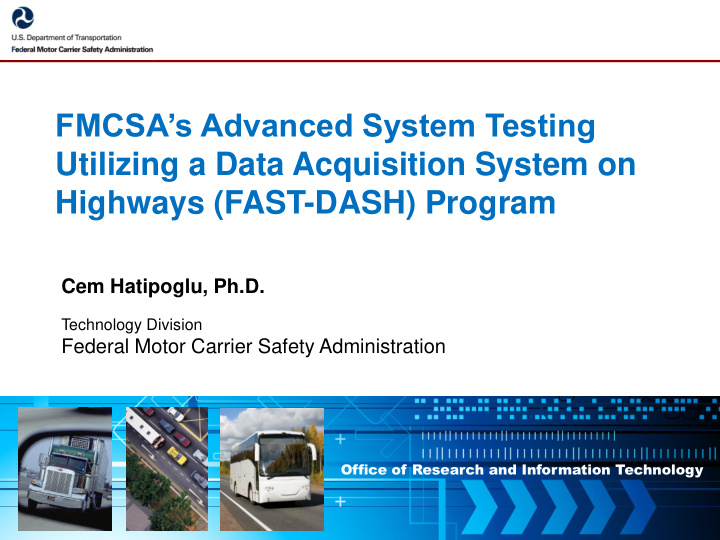



FMCSA’s Advanced System Testing Utilizing a Data Acquisition System on Highways (FAST-DASH) Program Cem Hatipoglu, Ph.D. Technology Division Federal Motor Carrier Safety Administration Office of Research and Information Technology
Overview FMCSA’s Onboard Safety System Research Area Priorities Research Decision Factors Examples FAST-DASH Program Objectives Structure Timeline Use of Naturalistic Driving Office of Research and Information Technology 2
Onboard Safety System Research Area Promising vehicular technologies, their premise, potentials and deployment of proven onboard safety systems (OBSS) In-service focused Critical Factors of importance Safety benefits Unintended consequences Reliability. Agency Authority, Reach, Impact, Enforcement Total cost of ownership, Purchase price Installation cost Maintenance cost Operational cost impact. An OBSS is a Commercial Motor Vehicle technology that provides a consistent and measurable net safety benefit to the driver, motor carrier and highway transportation. Office of Research and Information Technology 3
Onboard Safety System Research Decision Factors • Safety benefits • What Literature aimed by the exists on this technology OBSS type? • Avoid crashes • Will research yield Safety Research • Reduce severity of meaningful results? crashes Premise History Agency Research Mission Fitness OBSS Agency Research Technology Authority Future Evaluated • 49 U.S.C. §31108. Motor • How will/can the carrier research and results be used? technology program Office of Research and Information Technology 4
Onboard Safety System Categories By pre-crash scenarios Running red light, road edge departure/maneuver, changing lanes/same direction, drifting/same direction, etc By conflict zone Front, rear, side, blind-spot, etc By conflict type Rollover, fatigue, loss of control, blind-spot, etc By action type Training, coaching, warning, intervention, etc By vehicular platform Tractor based, trailer based, floating device, etc. Office of Research and Information Technology 5
Examples of Onboard Safety Systems Backup Object DSRC Fatigue Detection based Monitoring V2V, V2I Texting, cell phone use detection LDW AOBRD EOBR TRSC TPMS Driver Monitoring Currently Available Technology BSP ABS FCW In advanced stages LCW ATC ACC of development DTC CMBS Brake-stroke RSC In early stages of monitoring ESC development Office of Research and Information Technology 6
FAST-DASH Program Objectives 5-year cooperative agreement between FMCSA and VTTI A Technology Transfer Program Independent & Quick Turnaround testing and reporting Targets to test Marketed or near market-ready technologies Research plan / Experimental Design includes: Static functionality testing on Smart Road 6-month Naturalistic Driving FOT with 20 DASs on Fleet Vehicles Conflict based safety effectiveness assessment Analysis of participating Fleet’s accident risks from their records. Office of Research and Information Technology 7
FAST-DASH Program • Provide Funding • Project Selection • Project and Program Oversight FMCSA • Project Solicitation • Project Selection Recommendation • Participating Fleet Selection • DAS installation VTTI • Experiment , data collection, analysis, reporting, closure. • Technology to support the experiment • Staff to assist with installation, and maintenance Technology • Technology decommissioning Vendor • Provide access to their vehicles and drivers as necessary Fleet Office of Research and Information Technology 8
First Project under FAST-DASH Program First Project underway Blind spot object detection and warning system Data collection finished Analysis and reporting planned for the rest of CY12. Final Report anticipated in early CY13 Primary Decision Factors Pre-crash scenario study 1 by Volpe Center shows that in heavy trucks the leading pre-crash scenario was Changing lanes / same direction (13%) There are no documented results with robust BSW systems in the literature 1 Frequency of Target Crashes for IntelliDrive Safety Systems, DOT HS 811 381, October 2010, NHTSA. Office of Research and Information Technology 9
Naturalistic Driving Data Supports Evaluation Studies ~20 Vehicles at participating fleet instrumented with SHRP2 DAS, collects data from: Multiple cameras, forward radar Vehicle databus Onboard safety system being tested. 6 month data collection ~2 month baseline, ~4 month with system enabled 2k-8k miles/per month per vehicle data acquisition. Assessment of safety benefits Critical events relevant to the technology. Office of Research and Information Technology 10
For Additional Information, please contact Cem Hatipoglu, Ph.D. Federal Motor Carrier Safety Administration Office of Analysis, Research and Technology 1200 New Jersey Ave. SE Washington, DC 22031 202-385-2383 (W) cem.hatipoglu@dot.gov VTTI’s FAST -DASH site: http://www.vtti.vt.edu/ctbs-fast-dash.php Office of Research and Information Technology 11
Recommend
More recommend